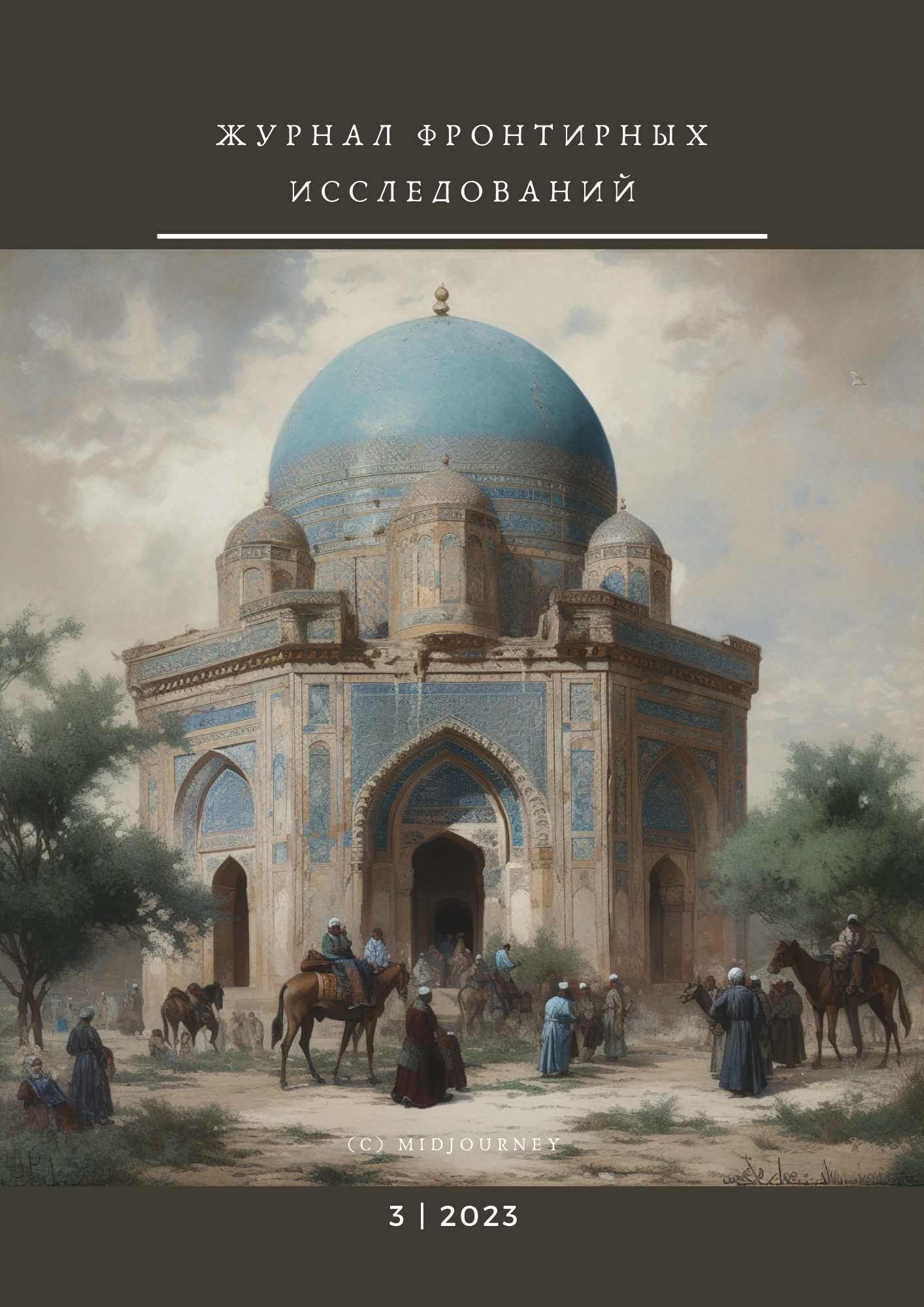Abstract
The article explores various films “about Eastern life” of the 1920s, conducting a historical and anthropological analysis of the content of these films and their reviews from the perspective of intercultural communication. The research methodology is grounded in the semiotic tradition and the communicative model proposed by Yu. M. Lotman. Printed media texts and visual sources (films) were used in the composition of this article. The aim of this piece is to expose the communicative functions of cinematography as a medium for information exchange and to ascertain the cognitive possibilities of silent cinema for the communicative interaction of the peoples of our country.
Films “from Eastern life” had to conform to certain criteria, taking into account the idiosyncrasies of the national mentality of the inhabitants of the eastern outskirts. The study revealed that legends were employed in scriptwriting as a phenomenon of folk spiritual culture. Films inspired by folklore depict architectural masterpieces and the diverse nature of different regions. The harem theme popular in Western Europe found its way into Soviet films “about Eastern life”, but the quest for the “false exotic of the East” often resulted in communication breakdowns. The “inauthentic” portrayal of the East did not resonate with viewers and film critics.
Nevertheless, silent films of the 1920s introduced the ethno-confessional characteristics of peoples, their history, traditional way of life, mores, and customs. These films contributed to the broadening of the national worldview, thereby confirming the high cognitive potential and significance of cinema in the intercultural communication within the multi-ethnic landscape of the USSR.
References
“Dolina slez”. (1924, December 16). Kino-gazeta. (In Russian).
“Legenda o Devich'ey bashne”. (1924, April 15). Kino-gazeta. (In Russian).
“Minarety i bayaderki… Bayaderki i minarety…”. (1926, April 6). Kino. Ezhenedel'naya gazeta. (In Russian).
“Musul'manka”. (1925, October 13). Kino. Ezhenedel'naya gazeta. (In Russian).
“Natella”. (1926, April 6). Kino. Ezhenedel'naya gazeta. (In Russian).
Agapova, S. G. (2004). Osnovy mezhlichnostnoy i mezhkul'turnoy kommunikatsii. Feniks. (In Russian).
Alekseeva, E. P. (2013). Kino Strany Sovetov v Kazani. Kinovedcheskie zapiski, 102–103, 379–412. (In Russian).
Bek-Nazarov, A. (1926). “Natella”. Sovetskiy ekran, 12, 5. (In Russian).
Eleferenko, I. O. (2010). Empatiya kak osnovanie kommunikatsii. Kul'turnaya zhizn' Yuga Rossii, 4(38), 33–36. (In Russian).
Grashchenkova, I. N. (2014). Kinoantropologiya XX/20. Chelovek. (In Russian).
Grishaeva, L. I., & Tsurikova, L. V. (2006). Vvedenie v teoriyu mezhkul'turnoy kommunikatsii. Izdatel'skiy tsentr “Akademiya”. (In Russian).
Istoriya natsional'nykh kinematografiy: Sovetskiy i postsovetskiy periody. (2020). Akademicheskiy proekt; Fond “Mir”. (In Russian).
Kak snimalas' “Legenda”: Beseda s rezhisserom-khudozhnikom V. V. Ballyuzek. (1924, April 15). Kino-gazeta. (In Russian).
Karimova, N. G. (2019). Kinoindustriya Uzbekistana i ee vklad v sotsial'no-ekonomicheskoe razvitie strany. Baktria press. (In Russian).
Karpova, Yu. A. (2010). Emotivno-empatiynyy komponent mezhkul'turnoy kommunikatsii. Vestnik Permskogo natsional'nogo issledovatel'skogo politekhnicheskogo universiteta. Problemy yazykoznaniya i pedagogiki, 4, 147–159. (In Russian).
Kartiny, kotorye nam pokazyvayut. (1926, January 19). Kino. Ezhenedel'naya gazeta. (In Russian).
Khan, O.V. (2021). “Emancipation of the Eastern Woman” in the 1920s: Ideology, Practice, and Cinematography. Herald of Anthropology (Vestnik Antropologii), 4, 215–229. https://doi.org/10.33876/2311-0546/2021-4/215-229 (In Russian).
Khloponina, O. O. (2017). The Transformation of Female Imagery in Soviet Cinema of the 1920–1930s. Knowledge. Understanding. Skill, 2, 140–151. https://doi.org/10.17805/zpu.2017.2.11 (In Russian).
Kosinova, M. I. (2014). The History of Relations Between Russian Cinema and its Audience. Knowledge. Understanding. Skill, 4, 147–155. (In Russian).
Krasina (Subbotina), O. S. (2020). Cinematography of Uzbekistan in the 1920s: the Birth of the National Cinema School. Ethnodialogues, 3(61), 204–219. (In Russian).
Krinichnaya, N. A. (1989). Kogda granit i letopis' bezmolvny... (Vstupitel'naya stat'ya). In Legendy. Predaniya. Byval'shchiny (pp. 5–21). Sovremennik. (In Russian).
Kurochkin, O. E. (2022). Yazyk kino. Kak stat' prodvinutym zritelem. Eksmo. (In Russian).
Lotman, Yu. M. (1973). Semiotika kino i problemy kinoestetiki. Eesti Raamat. (In Russian).
Malyshev, V. S. (2020). Istoriya natsional'nykh kinematografiy v SSSR – istoriya VGIK. In Istoriya natsional'nykh kinematografiy: Sovetskiy i postsovetskiy periody. Akademicheskiy proekt; Fond “Mir”. (In Russian).
Melikuziev, I. M., & Yuldashev, E. S. (2016). Istoriya i razvitie uzbekskogo iskusstva kino. Molodoy uchenyy, 19(123), 561–564. (In Russian).
Nikulin, L. V. (1925). Vostochnye sladosti. Kino. Ezhenedel'naya gazeta. (In Russian).
Nikulin, L. V. (1926). Pesni i kamni. Kino. Ezhenedel'naya gazeta. (In Russian).
Nikulin, L. V. (1934). Zapiski sputnika. Sovetskaya literatura. (In Russian).
Ol'khovits, B. S. (Ed.). (1929). Puti kino. Pervoe Vsesoyuznoe partiynoe soveshchanie po kinematografii. Teakinopechat'. (In Russian).
Otsenka GPP. (1926, February 9). Kino. Ezhenedel'naya gazeta. (In Russian).
Piotrovskiy, A. I. (1969). Teatr. Kino. Zhizn'. Iskusstvo. (In Russian).
Pochemu uzbeki smeyalis'. (1925, November 10). Kino. Ezhenedel'naya gazeta. (In Russian).
Postnikova, T. V. (2006). Communication of Cinematograph in Semiotic Conception of Yu.M. Lotman: Philosophical-Anthropological Analysis. Moscow University Bulletin. Series 7. Philosophy, 3, 11–31. (In Russian).
Raboty orientalistov. (1926, February 9). Kino. Ezhenedel'naya gazeta. (In Russian).
Sadokhin, A. P. (2004). Teoriya i praktika mezhkul'turnoy kommunikatsii. Yuniti-Dana. (In Russian).
Schneider, M. I. (2016). Empathy as a Form of Reflection of Another Person. Humanization of Education, 2, 60–64. (In Russian).
Skachko, A. E. (1925a). Vostochnaya kinofil'ma. Sovetskoe kino, 6, 24–26. (In Russian).
Skachko, A. E. (1925b). Kino i vostochnye narody SSSR. Sovetskoe kino, 1, 23–25. (In Russian).
Skachko, A. E. (1925c). Organizatsiya vostochnogo kino. Sovetskoe kino, 2–3, 16–18. (In Russian).
Smagina, S. A. (2018). The Screening Representation of the “New Woman” in the Soviet Cinematograph of the 20th. Articult, 32(4), 174–181. https://doi.org/10.28995/2227-6165-2018-4-174-181 (In Russian).
Sneg i znoy. (1925, September 1). Kino. Ezhenedel'naya gazeta. (In Russian).
Sovetskie khudozhestvennye fil'my. Annotirovannyy katalog: V 3 tomakh: Vol. 1: Nemye fil'my. (1918–1935). (1961). Iskusstvo. (In Russian).
Traynin, I. P. (1928). Kino na kul'turnom fronte. Teakinopechat'. (In Russian).
Traynin, I. P. (1930). Iskusstvo v kul'turnom pokhode na vostoke SSSR. Transpechat'. (In Russian).
Vel'tman, S. L. (1927). Zadachi kino na Vostoke. (Pravda i nepravda o Vostoke). Nauchnaya assotsiatsiya vostokovedeniya. (In Russian).
Yarmatov, K. Ya. (1980). Vozvrashchenie: Kniga vospominaniy. Iskusstvo. (In Russian).
Zorkaya, N. M. (2005). Istoriya sovetskogo kino. Aleteyya. (In Russian).

This work is licensed under a Creative Commons Attribution 4.0 International License.


